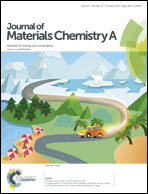The structure–property relationship of manganese oxides: highly efficient removal of methyl orange from aqueous solution†
Abstract
Manganese oxides of various crystal structures (α-, β-, γ- and δ-MnO2, Mn2O3, Mn3O4 and amorphous) were synthesized by facile methods. The adsorption capacities for methyl orange of these materials were investigated and the resulting materials were characterized by different techniques, such as SEM, XRD and BET surface area measurements. The adsorption capacities were strongly dependent on the crystallographic structures and morphologies, and followed the order of A-MnO2 > Mn2O3 > Mn3O4 > α-MnO2 nanowires > β-MnO2 > γ-MnO2 > α-MnO2 nanotubes >δ-MnO2, while the adsorption properties could be greatly improved by increasing the surface area and pore properties of the adsorbents. A-MnO2 was found to be the most effective adsorbent among the other materials and the adsorption process was systematically investigated. The adsorption kinetics data closely followed the pseudo-second-order kinetic model and the results obtained from the intraparticle diffusion model indicated that the overall process was jointly influenced by external mass transfer and intra-particle diffusion. The maximum adsorption capacity determined from the Langmuir isotherm model was 1488.7 mg g−1. Moreover, thermodynamic analyses revealed that the adsorption of MO onto A-MnO2 was spontaneous and exothermic, and the physical adsorption mechanisms including electrostatic interactions played a dominant role in the adsorption process between MO and A-MnO2. These combined results indicated that A-MnO2 is an efficient adsorbent for the removal of MO from wastewater.


 Please wait while we load your content...
Please wait while we load your content...